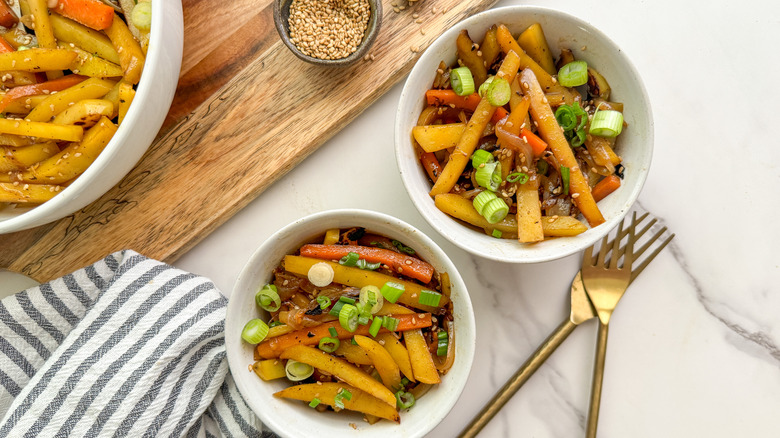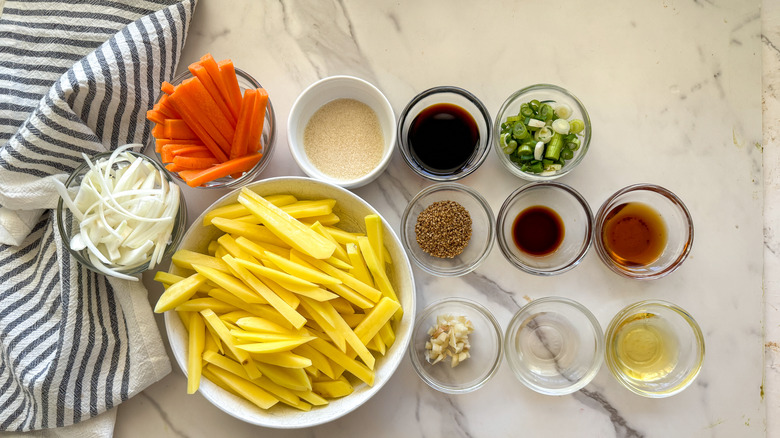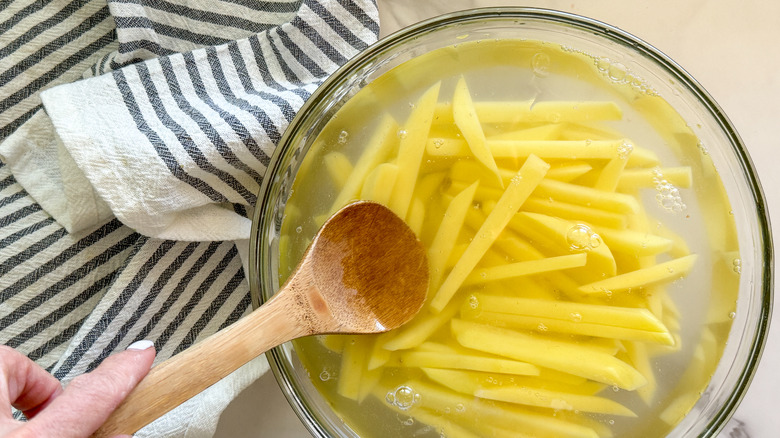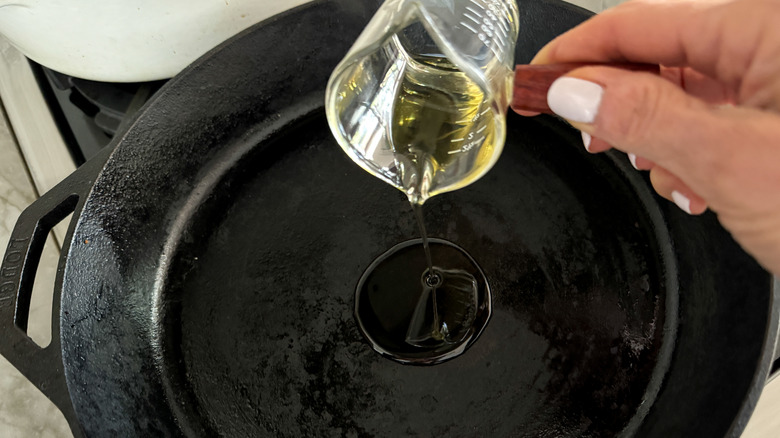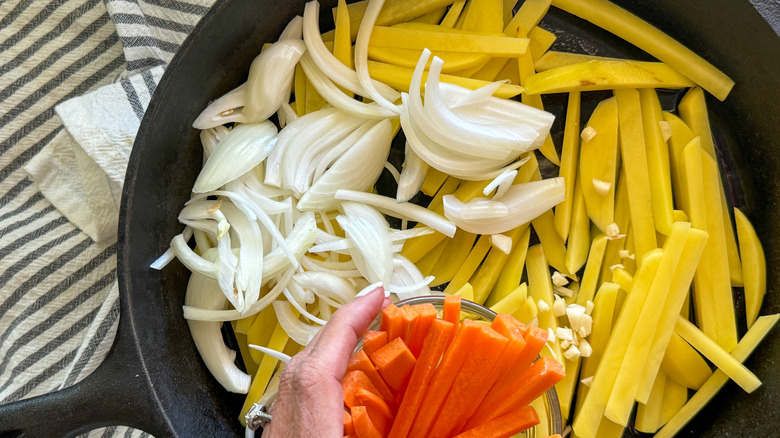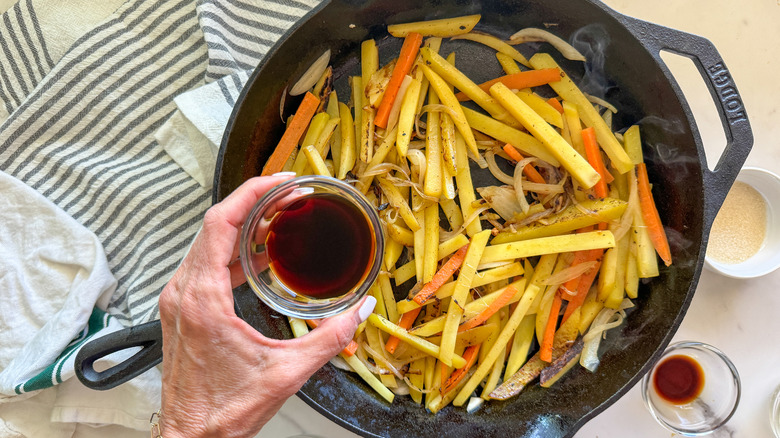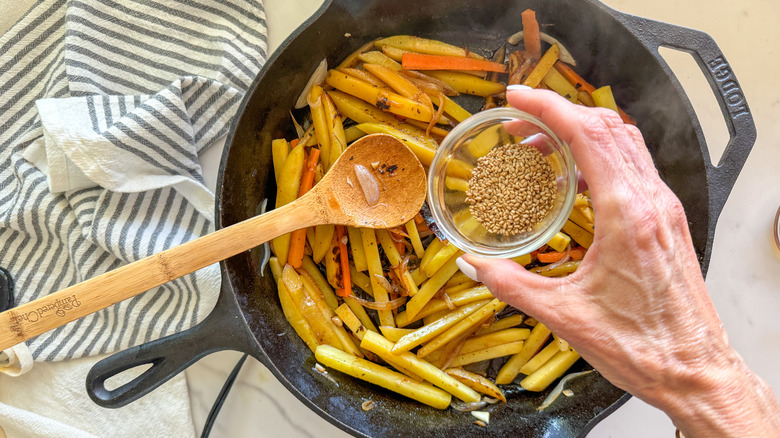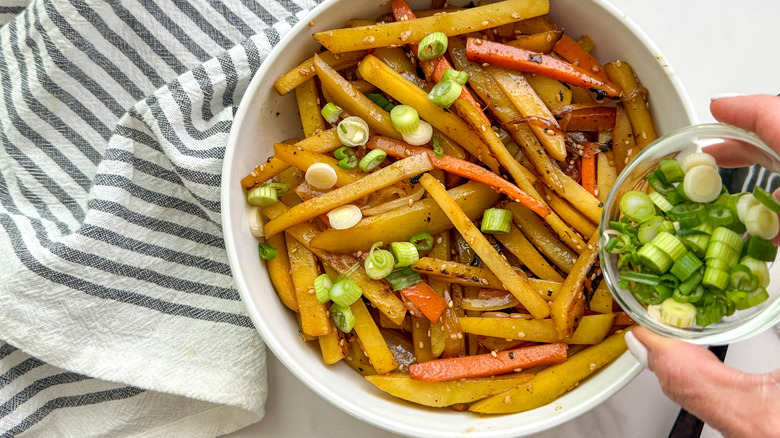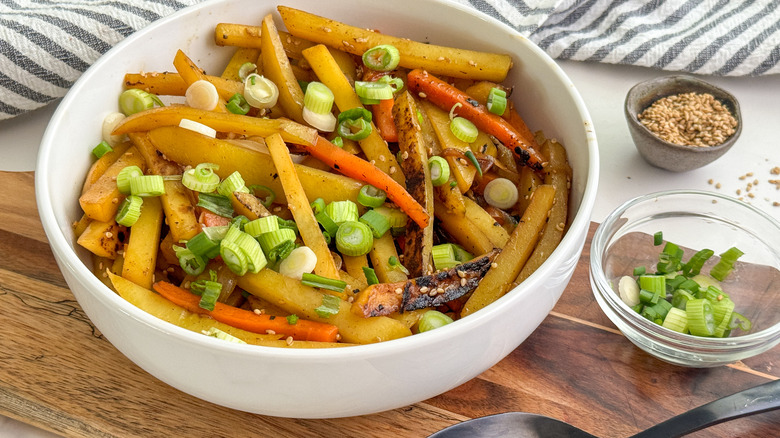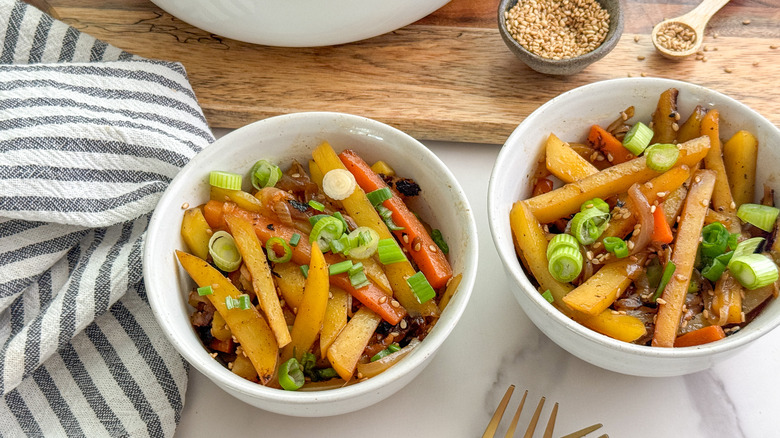Gamja Bokkeum (Korean-Style Potatoes) Recipe
Potatoes, which come in all shapes and colors, are a versatile staple that find their way into cuisines worldwide. From comforting mashed potatoes to crispy fries, this humble tuber can transform into all types of tasty dishes and is great for showcasing strong flavors. In Korean cuisine, potatoes take on a savory, flavorful twist in the form of gamja bokkeum, a dish with tender baton-cut potatoes, carrots, and onions cooked in an umami-flavored sauce. It is considered a type of banchan in Korean cuisine, which refers to a variety of small side dishes served alongside cooked rice in Korean meals.
Wellness coach and recipe developer Miriam Hahn brings us this recipe and says, "As a wellness coach, I encourage embracing dishes like gamja bokkeum that transform potatoes into a flavorful, fiber-rich side dish, proving that healthy eating can be both nutritious and delicious." Keep reading to learn how to make this dish, which is rich in history and flavor, in under half an hour.
Gather the ingredients for gamja bokkeum
To make this recipe, start in the produce aisle and pick up some Yukon gold potatoes, carrots, onions, garlic, and green onions. "I like using Yukon gold potatoes here because of their buttery texture and slightly sweet flavor, which perfectly complements the dish," Hahn shares.
The remaining items are where the flavor comes in. Grab some avocado oil, soy sauce, mirin, sugar, fish sauce, sesame oil, and toasted sesame seeds. If you're wondering what Mirin is and how to cook with it, it's a delicate rice wine used in cooking to add subtle sweetness. If you would like to make this dish vegan or vegetarian, simply leave out the fish sauce.
Step 1: Put the potatoes in ice water
Place the potatoes in a bowl of ice water for 5 minutes, then drain.
Step 2: Add oil to a pan
Add the avocado oil to a large frying pan and bring the heat to medium-high.
Step 3: Add the vegetables to the pan
Place the potatoes, carrot, onion, and garlic in the pan and cook for 15-20 minutes or until the potatoes are tender and the carrots have started to brown.
Step 4: Add the sauce ingredients
Add the soy sauce, mirin, sugar, and fish sauce, stir to combine and simmer for a few minutes to warm through.
Step 5: Add the sesame oil and seeds
Add sesame oil and sesame seeds.
Step 6: Garnish and serve the potatoes
Top with green onions and serve.
What is the history of gamja bokkeum?
Korean recipes are known for their bold flavors, vibrant colors, and the harmonious balance they strike between sweet, salty, spicy, and savory elements. Gamja bokkeum is a popular Korean dish that traces its roots back to the Joseon Dynasty (1392–1910). Originally, it was a humble meal created with simple ingredients reflecting the resourcefulness of Korean cuisine during challenging times. Over the years, the dish has evolved, with various regional and personal variations emerging.
Some versions, like this one, include additional ingredients like carrots, onions, and green onions, reflecting the creative adaptability of Korean cooking. In gamja bokkeum, the potatoes can be cut into various shapes, each offering a unique texture and aesthetic appeal. Small bite-sized cubes, thin slices, or even thick wedges are all workable options when making this dish.
Gamja bokkeum, with its hearty potatoes and rich flavors, adds a comforting touch to any Korean meal. Serving it as a banchan completes the meal, offering a delightful and well-rounded dining experience, and embodying the essence of Korean cuisine.
What can I pair with the gamja bokkeum?
Gamja bokkeum, which is often served as one element of a larger meal, pairs well with a variety of dishes to create a balanced and satisfying dinner. To start, a bowl of steamed white rice elevates the strong umami flavors and soaks up the rich sauce of the gamja bokkeum. You can pair gamja bokkeum with several other Korean dishes to complement its savory and slightly sweet flavor. One excellent choice is to serve it alongside a protein dish such as bulgogi, a marinated grilled beef dish, dak bulgogi, a marinated grilled chicken, tofu bulgogi, or dubu jorim (braised tofu). The combination of gamja bokkeum as a potato side with more of a main dish adds depth and variety to the meal.
To complete the meal, consider adding other side dishes such as kimchi, spicy cucumber salad, or kongnamul muchim (seasoned soybean sprouts). This combination creates a delightful and well-rounded Korean meal, offering a variety of flavors, textures, and colors to enjoy.
Gamja Bokkeum (Korean-Style Potatoes) Recipe
Gamja bokkeum, a flavor-packed dish with tender baton-cut potatoes, carrots, and onions cooked in an umami-flavored sauce comes together in under half an hour.
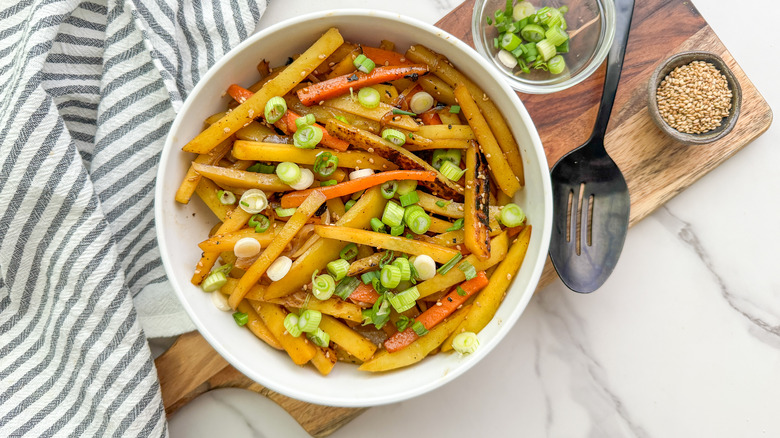
Ingredients
- 3 Yukon gold potatoes, peeled and cut into ¼-inch batons
- 2 tablespoons avocado oil
- 1 carrot, cut into ¼-inch slices
- ½ sliced onion
- 2 minced garlic cloves
- 3 tablespoons soy sauce
- 1 tablespoon mirin
- 1 tablespoon sugar
- 1 teaspoon fish sauce
- 2 tablespoons sesame oil
- 1 tablespoon toasted sesame seeds
- 2 chopped green onions
Directions
- Place the potatoes in a bowl of ice water for 5 minutes, then drain.
- Add the avocado oil to a large frying pan and bring the heat to medium-high.
- Place the potatoes, carrot, onion, and garlic in the pan and cook for 15-20 minutes or until the potatoes are tender and the carrots have started to brown.
- Add the soy sauce, mirin, sugar, and fish sauce, stir to combine and simmer for a few minute to warm through.
- Add sesame oil and sesame seeds.
- Top with green onions and serve.
Nutrition
| Calories per Serving | 299 |
| Total Fat | 15.2 g |
| Saturated Fat | 2.0 g |
| Trans Fat | 0.0 g |
| Cholesterol | 0.0 mg |
| Total Carbohydrates | 36.4 g |
| Dietary Fiber | 4.6 g |
| Total Sugars | 6.1 g |
| Sodium | 799.0 mg |
| Protein | 5.3 g |
